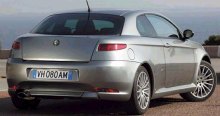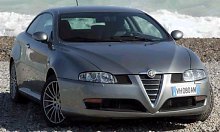Alfa Romeo GTDebut: 2003Maker: Alfa Romeo Predecessor: no |
 Alfa
Romeo is an interesting brand. While sales numbers of its mainstream
147,
157 and 166 remain low, it is spending a lot of resources into niche
models.
Today, its niche lineup include only the GTV / Spider twins, but 2
years
later this will grow to a 3 lines. On the top of the niche family will
be the 400-horsepower 8C Competizione sports car. Position beneath it
will
be the next generation GTV and Spider, taking inspiration from
Giugiaro’s
Brera concept car. At the lower end of the spectrum sits a more
practical
and affordable coupe based on the current 147 / 157 platform. Alfa
calls
this car simply "GT". Alfa
Romeo is an interesting brand. While sales numbers of its mainstream
147,
157 and 166 remain low, it is spending a lot of resources into niche
models.
Today, its niche lineup include only the GTV / Spider twins, but 2
years
later this will grow to a 3 lines. On the top of the niche family will
be the 400-horsepower 8C Competizione sports car. Position beneath it
will
be the next generation GTV and Spider, taking inspiration from
Giugiaro’s
Brera concept car. At the lower end of the spectrum sits a more
practical
and affordable coupe based on the current 147 / 157 platform. Alfa
calls
this car simply "GT".The Alfa GT was styled by Bertone. Unmistakably an Alfa, unmistakably a coupe version of the 147. Compare with 147, its more steeply raked windscreen, low roofline, short boot and optional 18-inch wheels create tensions on the body surface, making it looks sportier than BMW 3-series Coupe yet more elegant than both the 147GTA and 156GTA. Detailing is also fantastic, as you can see in the grille and front air intakes at the bumper. Nevertheless, the Bertone design does not break the mould from the current styling theme of Alfa Romeo. This is a bit disappointing for those who still remember how radical-thinking the great Italian styling house used to be. Though sculpted by Bertone, the car is produced by Alfa Romeo itself in the Naples factory alongside 147. It also shares most of its parts with the hatchback, including the dashboard you face as well as mechanical parts you can’t see. However, for the benefit of rear passengers, the GT sits on the same 2596mm wheelbase as the 156.  Just
like 147, the cabin of the GT is inviting, beautifully trimmed and has
better quality plastics than many German rivals. Higher-spec models
have
beautiful leather seats and a classy, two-ton leather trim all over the
cabin. Visibility is not great though, because of smaller glass area
and
thick C-pillars. Rear accommodation actually falls short behind the
147,
strangely, despite of the extended wheelbase. Tall passengers will find
both head and leg-room limited. However, by coupe standard it is never
impractical. The boot provides 320 litres of luggage space. Just
like 147, the cabin of the GT is inviting, beautifully trimmed and has
better quality plastics than many German rivals. Higher-spec models
have
beautiful leather seats and a classy, two-ton leather trim all over the
cabin. Visibility is not great though, because of smaller glass area
and
thick C-pillars. Rear accommodation actually falls short behind the
147,
strangely, despite of the extended wheelbase. Tall passengers will find
both head and leg-room limited. However, by coupe standard it is never
impractical. The boot provides 320 litres of luggage space.The Alfa GT is powered by the same engines as 147 and 156. This means 140hp 1.8 (twin-spark), 165hp 2.0 JTS (direct-injection) and 240hp 3.2 V6 in the petrol side, plus 150hp 1.9 Multi-jet inline-4 and, later on, 175hp 2.4 Multi-jet inline-5 in the diesel side. As the GT is heavier than the equivalent 147, it is also slightly slower. However, compare with the equivalent BMW 3-series Coupe it has an advantage in performance, because the GT is both lighter and more powerful. For example, the 2.0 JTS offers 22hp more than the 2.0-litre 318Ci yet weighs 70kg less. It is therefore 0.7 seconds quicker to accelerate from 0 to 60mph. Similarly, the V6 has an advantage of 9hp, 100kg and 0.3 sec. As usual, engines are the strong cards of Alfa, especially is the case of V6. Wonderfully smooth, revvy and lovely to the ears. The 2.0 engine is also a superb four-cylinder, no question. But now Alfa also shines in the diesel side, thanks to the Multi-jet common-rail turbo engines supplied by Fiat. Being powerful, flexible and extremely refined, they are really world-beater. Expect many of the customers will turn to the diesel camp. In the chassis side, the Alfa GT is still not good enough to trouble BMW 3-series Coupe, no matter handling and refinement. Yes, compare with 147GTA it is already an improvement, thanks to the 15% stiffer chassis and retuned suspensions. It rides smoother and quieter than 147 and balance better than it. However, its quick steering delivers less feel than the BMW and ride quality is no where near it. The V6 feels nose heavy beside a 330Ci. At the limit, you will be reminded it is front-wheel drive. In short, it doesn’t come close enough to the BMW in the dynamic aspect. One thing stand on its side, however. It is price. 15% cheaper than an equivalent 3-series Coupe is undoubtedly attractive.... until you meet a Mazda RX-8. |
| The above report was last updated on 29 Nov 2003. All Rights Reserved. |


